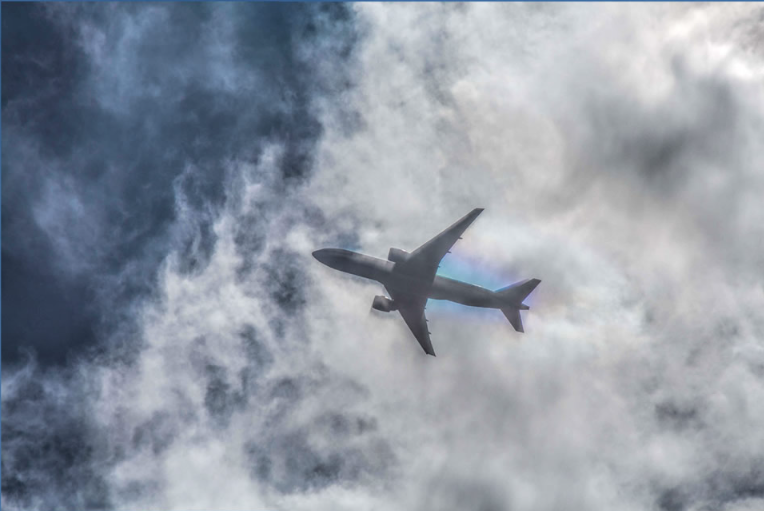Airplane Iridescence - OPOD
Airplane Iridescence - OPOD: Unveiling the Colorful Phenomenon
Airplane iridescence, also known as airframe-induced iridescence, is a captivating atmospheric optics phenomenon that occurs when an aircraft passes through sunlit moist air. While the engines and tail plane cast long shadows, it is the wings that leave behind intense iridescent trails. The mesmerizing display of colors is a result of the interaction between airflow over the airframe, water vapor condensation, and sunlight diffraction.
When air passes over the top of wings or convex fuselage sections, it travels faster and undergoes expansion, causing adiabatic cooling. In humid conditions, this rapid cooling leads to the condensation of water vapor into a cloud of small droplets. Similar to the formation of pileus clouds atop thunderheads or banner clouds waving from mountain peaks, the iridescent colors are produced by individual water droplets diffracting sunlight.
The phenomenon of airplane iridescence is further enhanced when the water droplets in the cloud are locally of similar size. This uniformity in droplet size allows them to diffract their colored light into the same direction, resulting in the vivid display of colors that becomes evident to us. It is this diffraction of light that gives rise to the iridescent effect, where different wavelengths of light are separated and scattered, creating a stunning array of colors.
To fully appreciate airplane iridescence, it is essential to understand the role of diffraction in creating this optical spectacle. Diffraction refers to the bending or spreading of light waves as they encounter an obstacle or pass through a narrow opening. In the case of airplane iridescence, the water droplets act as obstacles or narrow openings for the sunlight to interact with, causing the light waves to diffract and produce the vibrant colors we observe.
The colors observed in airplane iridescence can vary depending on the size and shape of the water droplets, as well as the angle at which the sunlight interacts with them. Common colors that may be seen include shades of red, orange, yellow, green, blue, and violet. These colors can appear as bands or patches of vibrant hues, adding a touch of enchantment to the aircraft's presence in the sky.
It is important to note that airplane iridescence is a natural optical phenomenon and should not be confused with artificial light effects, such as those created by aircraft lighting systems or exhaust emissions. The beauty of airplane iridescence lies in its connection to the atmospheric conditions and the interplay between sunlight, water droplets, and diffraction.
Next time you catch a glimpse of an aircraft sailing through sunlit moist air, take a moment to appreciate the captivating display of airplane iridescence. Witness the wings leaving behind trails of intense colors, created by the condensation of water droplets and the remarkable process of sunlight diffraction. Let this ethereal phenomenon remind you of the wonders that can unfold when nature and light come together in perfect harmony.
Please note that this article has been automatically converted from the old site and may not appear as intended.

Airframe Induced Iridescence
Lillian Kwok captured this aircraft low over North London. It sails through sunlit moist air its wings, engines and tail plane casting long shadows. Its wings rather than any engine exhaust leave intense iridescent trails. Airflow over the airframe causes water vapour to condense into tiny droplets and then sunlight and diffraction do their colourful work.
All images ©Lillian Kwok, shown with permission

Air passing over the top of wings or convex fuselage sections travels faster, expands and adiabatically cools. If the air is sufficiently humid, as here, water vapour then condenses out into a cloud of small droplets. We see the same when pileus cloud forms atop thunder heads or banner clouds wave from mountain peaks..
The iridescent colours are produced by individual water droplets diffracting sunlight. When the droplets are locally of similar size they all diffract their coloured light into the same direction and so colours become evident to us.

Note: this article has been automatically converted from the old site and may not appear as intended. You can find the original article here.
Reference Atmospheric Optics
If you use any of the definitions, information, or data presented on Atmospheric Optics, please copy the link or reference below to properly credit us as the reference source. Thank you!
-
<a href="https://atoptics.co.uk/blog/airplane-iridescence-opod/">Airplane Iridescence - OPOD</a>
-
"Airplane Iridescence - OPOD". Atmospheric Optics. Accessed on April 20, 2024. https://atoptics.co.uk/blog/airplane-iridescence-opod/.
-
"Airplane Iridescence - OPOD". Atmospheric Optics, https://atoptics.co.uk/blog/airplane-iridescence-opod/. Accessed 20 April, 2024
-
Airplane Iridescence - OPOD. Atmospheric Optics. Retrieved from https://atoptics.co.uk/blog/airplane-iridescence-opod/.